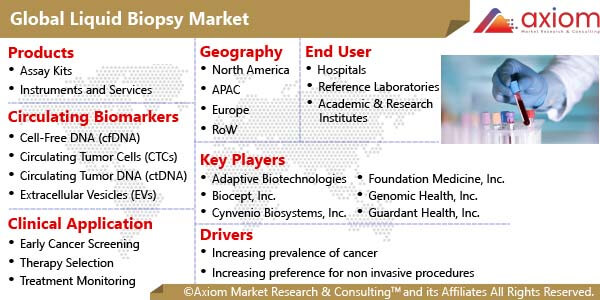Liquid biopsy is a minimally invasive technology for detection of molecular biomarkers without the need for expensive or invasive procedures. It is a simple and non-invasive alternative to surgical biopsies which enables medical doctors to discover a range of information about a disease or a tumour through a simple blood sample. Unlike tissue biopsy where the tumor DNA is preserved in formalin-fixed paraffin embedded (FFPE) blocks, DNA cross linking does not occur with liquid biopsy; thereby facilitating tumor DNA sequencing. In June 2016, the FDA approved the first liquid biopsy test, the cobas EGFR Mutation Test, as a cfDNA test for the EGFR gene mutation in blood from lung cancer patients. Currently, there continues to be a growing interest in the liquid biopsy assay, including an increasing number of companies involved in the development of these tests for the diagnosis and stratification of cancer patients.
Liquid Biopsy Market Outlook
The global liquid biopsy market is observing significant growth owing to advantages of liquid biopsy over solid tumor biopsy, rise in awareness about minimally invasive procedures, favorable government initiatives, and presence of huge cancer population base. Easy and non-invasive access to the tumor genome, early cancer diagnosis & detection, characterization of new lesions, drug & therapeutic target identifications for cancer treatment are some advantages of liquid biopsies, which improve the safety and efficiency of cancer therapy for patients. According to the Indian Council for Medical Research (ICMR), the number of cancer cases is expected to drastically increase. India is likely to have over 17.3 lakh new cases of cancer and over 8.8 lakh deaths due to the disease by 2020. Therefore, it is important to find better ways to detect cancer early and improve management strategies for better treatment outcomes. However, low sensitivity and specificity of liquid biopsy is hampering the market growth.
Liquid Biopsy Market Segmental Overview
The report analyses the global liquid biopsy market based on products, circulating biomarker, sample type, application, end user and geography.
Liquid Biopsy Market by Products
Based on products, the market is categorized into assay kits, instruments and services. The liquid biopsy instruments automate the isolation of CTC cells. The instrument automates flow cell priming, blood sample loading, target cell isolation, and immunofluorescent labeling of captured cells on the flow chip.
Liquid Biopsy Market by Circulating Biomarker
Various circulating biomarkers of the liquid biopsy market are Cell-Free DNA (cfDNA), Circulating Tumor Cells (CTCs), Circulating Tumor DNA (ctDNA), Extracellular Vesicles (EVs) and Other circulating biomarkers include circulating RNA (ctRNA and cfRNA) and cell-free protein biomarkers. Since liquid biopsies can detect tumor-associated genetic alterations, they can be used to molecularly stratify tumors to guide the most appropriate targeted treatment for precision oncology.
Liquid Biopsy Market by Clinical Application
Based on clinical application the industry is bifurcated into early cancer screening, therapy selection, treatment monitoring, recurrence monitoring. Liquid biopsy can be used to detect mutations in cases where the number of tumour cells is insufficient for tumour genetic analysis. It is also suggested for difficult-to-reach tumors and in patients in whom invasive sampling is contraindicated, as in such cases no tissue or cell material can be obtained from the tumour.
Liquid Biopsy Market by Application
The liquid biopsy industry finds its major application for cancer (breast cancer, colorectal cancer, liver cancer, lung cancer, prostate cancer) and non-cancer applications (NIPT, transplant diagnostics, others).
Liquid Biopsy Market by End User
Various end users of the liquid biopsy market are hospitals, reference laboratories, academic & research institutes and others. The availability of advanced genetic testing equipment has led an increased volume of liquid biopsy test samples outsourced to reference laboratories globally.
Liquid Biopsy Market by Geography
By geography, the global liquid biopsy market is studied across the countries of key regions such as, North America, Europe, Asia Pacific and rest of the world. In 2019, North America held the largest revenue share mainly due to factors such as government support for quality healthcare, high purchasing power parity and availability of reimbursement. Furthermore, Asia Pacific is expected to witness lucrative growth over the forecast period owing to supportive government initiatives, pioneering presence in healthcare development and rapid adoption of the technological innovations. Additionally, economic developments in countries, such as India and China, are expected to help spur the market growth. Huge population base with low per capita income in the region led to high demand for affordable treatment options.
Liquid Biopsy Market Key Players
The leading liquid biopsy market players are are Adaptive Biotechnologies, Biocept, Inc., Cynvenio Biosystems, Inc., Foundation Medicine, Inc., Genomic Health, Inc., Guardant Health, Inc., Myriad Genetics, Inc., NeoGenomics Laboratories, Inc., OncoCyte Corporation, Personal Genome Diagnostics, Inc., QIAGEN, RainDance Technologies, Inc., Trovagene Inc., Veracyte, Inc, Inc. and Vermillion, Inc. among others. Many biotechnological companies have started their trials in China as clinical trial regulations are comparatively soft, thus, encouraging businesses to shift their base from America and Europe, where costlier trials are required for approval and reimbursement. The growing investments in research and development of healthcare industry have been encouraging the market players to offer effective solutions to gain a competitive edge in the liquid biopsy market.











